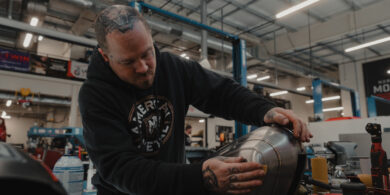The ride: Expect ‘motorcycle-like acceleration’ – February 12, 2007
Besides looking like a snowmobile on wheels, the Spyder’s seating position is very snowmobile-esque.
The first thing I noticed is the anti-lock brakes are all linked and are operated by the right foot lever, or the rear brake on a traditional motorcycle, which I rarely use, leaving the space where a front brake lever would normally be completely empty. Needless to say, coming to a stop the first few times was a little unnerving, but I soon adjusted.
Can-Am says the system is just like using the brakes in a car. Thankfully the clutch and gear selector were in their normal positions.
On the road, the pre-production Spyder felt like a convertible sports car with a funky seating position. Nonetheless, it was still comfortable for the entire ride. But before I could take my first ride, I had to back out of my parking space with the reverse gear. Yes, the Spyder is equipped with a gear-driven reverse — located by a toggle switch on the left handlebar.
Once moving, the Rotax engine really came on strong and provided motorcycle-like acceleration, assuming the traction control didn’t kick in, but more on that later.
Another issue was an annoying amount of heat on my right leg coming from the radiator. The radiator is positioned to the right of the engine to accommodate the oil cooler to the left and the body cowling is shaped to act as a duct to feed the radiator cool air while moving. Unfortunately, that also means that it dumps hot air straight to the rider’s leg. It wasn’t a big issue as my leg didn’t get burned, but it was noticeable.
Florida isn’t known for its abundance of twisty roads, but while winding through a few ones I did find the power-assisted steering to be precise, reacting to the slightest bar input. Unlike a motorcycle, however, the Spyder steers into turns.
The Spyder’s Vehicle Stability System is always on – great for the average consumer, downer for those looking for more sport with their touring. The “ride” of the Spyder feels like that of a car. Bumps get absorbed with little input to the rider (or is that driver?) whereas on a motorcycle every imperfection gets transferred through the suspension to the rider. For example, on the highway at night you’ll notice that a motorcycle’s headlight will “bounce” over the slightest bump. Not on the Spyder.
Troy Siahaan is the Road Test Editor at Rider Magazine. He has ridden everything from the most powerful sport bikes to fuel-sipping scooters and has raced his Suzuki SV650 for the past two years.




